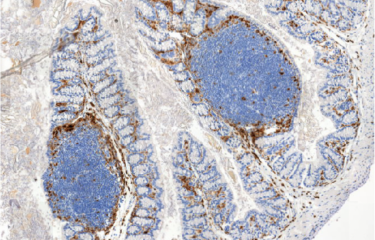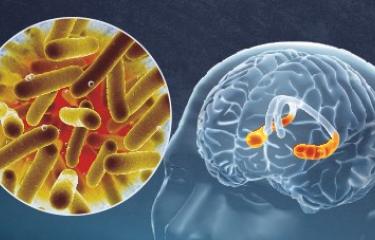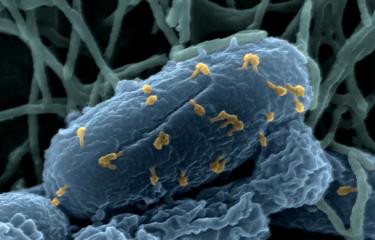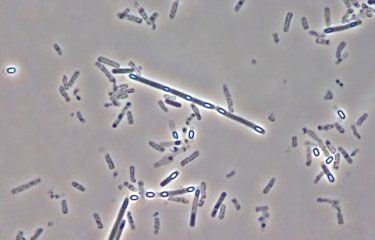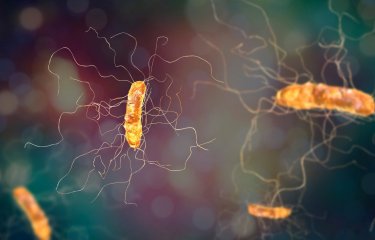During infection, the pathogenic bacterium interacts closely with the bacteria in the gut. They may have to share resources, thereby limiting infection with the pathogen, or alternatively the pathogen may draw benefits from this cohabitation for its infectious strategy.
Infection with Clostridioides difficile is the main cause of infectious diarrhea in hospitals and long-term care facilities. Exposure to antibiotics destroys the protective role of the gut microbiota, thereby encouraging the emergence of this pathogenic bacterium and allowing it to develop without resistance in the colon. Extensive research has been carried out to elucidate the way in which commensal bacteria in the gut microbiota provide protection. An international study published in Cell Host & Microbe, in which the Institut Pasteur participated, recently determined the molecular mechanisms used by the microbiota to prevent or aggravate C. difficile infection.
Bacteria in the microbiota compete with the pathogen or encourage its development
Using germ-free mice, the scientists demonstrated that when commensal bacteria with varying metabolic capabilities are introduced, the microbiota is capable of modulating the degree of virulence of C. difficile and its survival in the host. This is the case for Paraclostridium bifermentans, a species that competes with C. difficile for the nutrients it needs for growth, such as amino acids. Conversely, Clostridium sardiniense is a species that is capable of actively feeding C. difficile with products from its metabolism. The mice colonized with P. bifermentans survived infection with C. difficile, while those colonized with C. sardiniense rapidly succumbed.
The protective effects were reproduced in infected conventional mice that were given P. bifermentans via oral bacteriotherapy. "The diametrically opposed viability phenotypes that we observed with these two commensal bacteria enabled us to determine the crucial impact of available gut nutrients during disease on the behavior of C. difficile," explains Bruno Dupuy from the Pathogenesis of Bacterial Anaerobes laboratory at the Institut Pasteur. These mechanisms reveal the broader strategies used by the commensal microbiota to offer protection against pathogenic agents by limiting the nutrients that help them to colonize and infect the gut. As Bruno Dupuy continues, "by using in vivo techniques to perform an organizational analysis of host-commensal-pathogen interactions, we should be able to develop targeted bacteriotherapy to treat and prevent these infectious diseases."

The diagram summarizes how commensal bacteria control Clostridioides difficile virulence. The mice colonized with Paraclostridium bifermentans (PBI) survived C. difficile infection with much less severe disease, while the mice colonized with Clostridium sardiniense (CSAR) rapidly succumbed. Systematic in vivo analyses revealed how each commensal species modifies the nutritional environment in the gut. These differences modulate the metabolism, cellular machinery, stress responses and toxin production of C. difficile. The changes also modify the host response, which plays an important role in the virulence of the pathogen. The elements underlined in yellow and blue respectively indicate positive and negative regulation of the associated genetic programs in vivo, while orange indicates constitutive expression levels. © 2019, Massachusetts Host-Microbiome Center
This study is part of the priority scientific area Antimicrobial Resistance of the Institut Pasteur's strategic plan for 2019-2023.
Source :
In vivo commensal control of Clostridioides difficile virulence, Cell Host & Microbe, 11 novembre 2021 https://www.sciencedirect.com/science/article/pii/S1931312821004236
Brintha P. Girinathan1, Nicholas DiBenedetto1, Jay N. Worley1,2, Johann Peltier3,4, Mario Arrieta-Ortiz5, Rupa Immanuel5, Richard Lavin1, Mary L. Delaney1,6, Christopher Cummins1, Maria Hoffman7, Yan Luo7, Narjol Gonzalez Escalona7, Marc Allard7, Andrew B. Onderdonk1,6, Georg K. Gerber1,8, Abraham L. Sonenshein9, Nitin Baliga5, Bruno Dupuy3, Lynn Bry1,7
- Massachusetts Host-Microbiome Center, Dept. Pathology, Brigham & Women’s Hospital, Harvard Medical School, Boston, MA02115, USA
- National Center of Biotechnology Information, National Library of Medicine, Bethesda, MD 20894, USA
- Institut Pasteur, Université de Paris, UMR-CNRS2001, Laboratoire Pathogenèse des Bactéries Anaérobies, F-75015 Paris, France.
- Institute for Integrative Biology of the Cell (I2BC), Université Paris-Saclay, CEA, CNRS, 91198, Gif-sur-Yvette cedex, France.
- Institute of Systems Biology, Seattle, WA 98109, USA
- Clinical Microbiology Laboratory, Department of Pathology, Brigham & Women’s Hospital, Boston, MA.02115, USA
- Center for Food Safety and Applied Nutrition, United States Food and Drug Administration, Department of Health and Human Services, College Park, MD20740, USA
- Harvard-MIT Health Sciences & Technology, Cambridge, MA 02139, USA
- Department of Molecular Biology and Microbiology, Tufts University School of Medicine, Boston, MA 02111, USA




